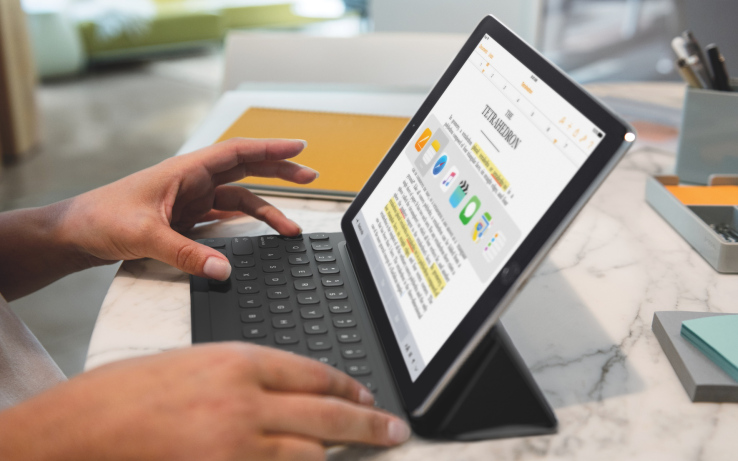

In the past month, both Apple and Samsung have refreshed their flagship tablets for the first time since 2014. A lot has changed in the space in the intervening years — mostly for the worse, as overall sales have continued to slip. In Q4 of last year, IDC reported that shipments had dropped 20 percent, year over year, while Strategic Analytics has the number at half that.
There’s room for debate as far as precisely how down the overall market is (not to mention what precisely qualifies a device as a tablet), but there seems to at least be a consensus that early predictions of the tablet space eclipsing PCs missed the mark. The space has suffered for a variety of reasons. Among them, the fact that users simply aren’t refreshing tablets at a rate many manufacturers no doubt predicted.
“The iPad 2 is still in use today,” IDC Senior Analyst Jitesh Ubrani tells TechCrunch. “The [original] iPad Minis and Air are all still in use today. They were being supported by Apple until very recently. People have been hanging onto these devices and they’re finding that they work just as well as they did when they were released.”
There are a few reasons for this. For one thing, users haven’t been conditioned to upgrade slates on the same cycle as smartphone — something that’s been hammered into consumers in almost Pavlovian fashion through carrier upgrade cycles.
There’s also the simple fact that we tend not to put the devices through the same sort of day to day wear and tear of smartphones, or even laptops, with many users simply leaving their devices at home and breaking them out when it’s time to watch some Netflix.
Strategy Analytics senior analyst Eric Smith points to a disappointing upgrade cycle as a contributing factor to the lack of excitement surrounding tablets, singling out today’s iPad refresh as a case in point. “Absent any big innovations like a flexible screen or 4K panels,” he tells TechCrunch, “you’re really not going to be able to induce replacement the way that they have been over the last few years.”
The growing size of smartphone displays has gone a ways toward cannibalizing tablet sales, as well, limiting the need for a much larger device when so many handsets are now within the six-inch range. On the high end of the spectrum, convertible touchscreen Windows 10 devices have eaten into tablet market share, while Chromebook sales have begun to dominate the education market that tablet makers once saw as a key use case.
Mikako Kitagawa of Gartner also suggests that part of the slow down in sales can be chalked up to user disappointment in the devices’ limitation following the initial excitement around the space. “When users started using the tablets, they realized that the devices had limitations versus a PC,” she tells TechCrunch. “There’s also a limitation for the device on the go. They’re too bulky to bring anywhere.”
So, as some users have opted out of the regular upgrade cycle, plenty more are simply content with two devices, instead of three. And as phones get bigger and PCs become more tablet-like, the gap between them only continues to shrink.
Today’s price drop could well signal Apple’s response to a contracting market, as the company tries to further incentivize refreshes, push hesitant purchasers over the edge and convince iPad owners that maybe the time is right to become a two tablet household. After all, the drop follows a significant price cut from the company’s iPad Pro line back in September.
And it could well prove a bellwether for premium tablets across the industry. After all, Samsung announced last week that it would be pricing the Tab S3 at $599. Don’t be too surprised to see the company slash it to something more competitive in the wake of this week’s iPad announcement.
It’s all part of what could be an industry-wide race to the middle, as premium devices drop in price and many makers of cheaper slates simply decide the margins are no longer worth it. After all, Amazon marks a rare bright spot on that end of the spectrum, due to its relatively unique ability to subsidize costs as it positions Fire tablets as, essentially, content delivery devices. Though Kitagawa does suggest that the low end may get a bit of a reprieve as children’s tablets get a bit of a bump.
Whatever the case, the consensus at present seems to be that tablet sales are likely to continue to erode for the foreseeable future. The introduction of new devices from the category’s two biggest sellers may stem the bleeding a bit for the quarter, but most seem to believe we’re not out of the woods yet.
It’s no coincidence that companies have shifted focus back to smartphones and other categories. Samsung’s Tab S3 announcement felt more like stop-gap as the company planned its big new phone launch, devoting the end of the event to the announcement of its announcement. Today’s iPad launch this morning, meanwhile, took the form of new release, rather than a big, keynote-style unveiling.
The tablet space isn’t doomed, of course. Companies are still shipping tens of millions of units a quarter. But until the next revolution comes along, it’s time to temper those expectations.

